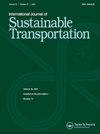A global overview of Bike Bus: A journey toward a child-friendly city
IF 3.9
3区 工程技术
Q2 ENVIRONMENTAL STUDIES
International Journal of Sustainable Transportation
Pub Date : 2024-12-01
DOI:10.1080/15568318.2024.2432654
引用次数: 0
Abstract
Cities are still far from being child-friendly for cycling. Cycling with children in low-cycling cities poses specific challenges, requiring high confidence and skills. Active travel-to-school programs aim to promote cycling among children, and one of these programs, Bike Bus, has recently captured considerable attention. Bike Bus is an initiative where families cycle together to school following a fixed route and schedule. This study aims to trace the origins of this initiative worldwide, explain the current momentum behind the movement, identify their diversity, and reflect on their long-term sustainability. We reached 431 Bike Buses through a mixed-methods design, including archival analysis, an online survey, and 22 interviews. Bike Bus had a plural origin in Europe in the late twentieth century. Moving more than 35,000 children in a week, its expansion has been driven by the joy it brings to participants, the growing interest in climate action, and social media. This is the first study that examines the characteristics of different Bike Buses and analyzes the particularities of this initiative. On average, the rides have 29 participants and travel 2.8 km. We compare route characteristics, participants, goals, and relationships with their respective city councils. Finally, while not all initiatives aim to last, access to long-term funding and committed organizers are the best enablers for sustainability over time. Bike Bus’ powerful nature lies in its simultaneous purposes: active mobility to school, activism, and joy. To ensure longevity, organizers could collaborate with local administrations to secure resources while maintaining advocacy for child-friendly cities.
自行车巴士全球概览:通往儿童友好城市的旅程
城市离适合儿童骑自行车还有很远的距离。在自行车骑行率低的城市,带着孩子骑自行车是一项特殊的挑战,需要很高的信心和技能。积极的上学旅行项目旨在促进孩子们骑自行车,其中一个项目“自行车巴士”最近引起了相当大的关注。自行车巴士是一项倡议,让家庭按照固定的路线和时间表一起骑车上学。本研究旨在追溯全球范围内这一倡议的起源,解释运动背后的当前势头,确定其多样性,并反思其长期可持续性。我们通过档案分析、在线调查和22个访谈等混合方法的设计,对431个自行车巴士进行了调查。自行车巴士在二十世纪后期的欧洲有多个起源。一周内接待了超过3.5万名儿童,它的扩张是由它给参与者带来的快乐、对气候行动日益增长的兴趣和社交媒体推动的。这是第一次研究不同的自行车巴士的特点,并分析了这一举措的特殊性。平均有29人参加,行程2.8公里。我们比较路线的特点、参与者、目标以及与各自市议会的关系。最后,虽然不是所有的倡议都以持久为目标,但获得长期资金和坚定的组织者是长期可持续发展的最佳推动者。自行车巴士的强大之处在于它的同时目的:积极的移动性、行动主义和快乐。为了确保长寿,组织者可以与当地政府合作,确保资源,同时继续倡导儿童友好型城市。
本文章由计算机程序翻译,如有差异,请以英文原文为准。
求助全文
约1分钟内获得全文
求助全文
来源期刊
CiteScore
8.90
自引率
2.60%
发文量
56
期刊介绍:
The International Journal of Sustainable Transportation provides a discussion forum for the exchange of new and innovative ideas on sustainable transportation research in the context of environmental, economical, social, and engineering aspects, as well as current and future interactions of transportation systems and other urban subsystems. The scope includes the examination of overall sustainability of any transportation system, including its infrastructure, vehicle, operation, and maintenance; the integration of social science disciplines, engineering, and information technology with transportation; the understanding of the comparative aspects of different transportation systems from a global perspective; qualitative and quantitative transportation studies; and case studies, surveys, and expository papers in an international or local context. Equal emphasis is placed on the problems of sustainable transportation that are associated with passenger and freight transportation modes in both industrialized and non-industrialized areas. All submitted manuscripts are subject to initial evaluation by the Editors and, if found suitable for further consideration, to peer review by independent, anonymous expert reviewers. All peer review is single-blind. Submissions are made online via ScholarOne Manuscripts.

 求助内容:
求助内容: 应助结果提醒方式:
应助结果提醒方式:


